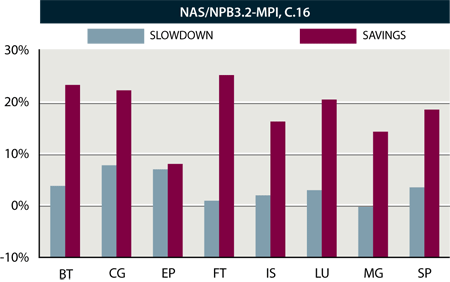Because many systems researchers argue that the low-power architectural approach sacrifices too much performance for low power consumption and high reliability, an alternative approach in HPC has recently emerged — one that is more architecture-independent than the low-power, architectural approach and one that takes the “middle ground” relative to the tradeoff between performance and low power consumption. This alternative approach is a power-aware, software-based one, as described in the cited feasibility studies25 26 27 28 29 and autonomic systems.30 31 32 33 The basic idea is to start with a high-performance, high-power CPU that supports a mechanism called dynamic voltage and frequency scaling (e.g., an AMD Opteron with support for PowerNow!) and then to create a power-aware algorithm (i.e., policy) that conserves power by scaling down the CPU supply voltage and frequency at appropriate times, as power draw is directly proportional to the CPU frequency and the square of the CPU supply voltage.
Ideally, the appropriate time to scale down the CPU voltage and frequency is whenever there is an off-chip access that the CPU is blocking-on, e.g., memory access, as the CPU has no reason to “sit and spin its wheels” at the maximum voltage and frequency while waiting for the off-chip accesses to complete. In practice, however, knowing when to scale the voltage and frequency and what to scale them to are difficult tasksfor the following reasons. First, off-chip memory accesses are done in hardware, thus power-aware software would have no way of knowing that the CPU is waiting on a memory access. Second, changing the voltage and frequency settings must be done judiciously, because at the system level, it currently takes on the order of milliseconds (i.e., millions of clock cycles) for the voltage and frequency to transition and stabilize at their new settings.
The current and most ubiquitous approach for power-awareness is based primarily on CPU utilization and is meant to extend the battery life in a laptop computer. When the CPU utilization drops below some threshold, the CPU voltage and frequency are lowered to conserve energy; when the CPU utilization exceeds some threshold, the CPU voltage and frequency are raised to improve performance. While this simple approach is both application and input independent as well as transparent to the end user, it is only effective for interactive use, e.g., laptop usage of Microsoft Office, and depends critically upon the choice of the threshold values.34 For scientific applications, the approach is ineffective as such applications do not have an abundance of CPU idle time that can be taken advantage of.32 Therefore, there exists a need for a power-aware algorithm that works effectively on scientific applications.
We propose such a power-aware algorithm called β-adaptation, which works on any commodity platform that supports dynamic voltage and frequency scaling (DVFS)33, e.g., AMD Opteron with PowerNow! Implementing the algorithm in the run-time system results in a power-aware runtime system that transparently and automatically adapts CPU voltage and frequency in order to reduce power and energy consumption while minimizing impact on performance. For example, Figure 4 shows that our power-aware run-time system running NAS-MPI Class C on a four-node, 16-CPU Opteron-based cluster saves nearly an average of 20% CPU energy while impacting performance by only 3% on average. (Note: For the MG benchmark, our β-adaptation algorithm not only reduces energy consumption by 14% but it also improves performance slightly.)







